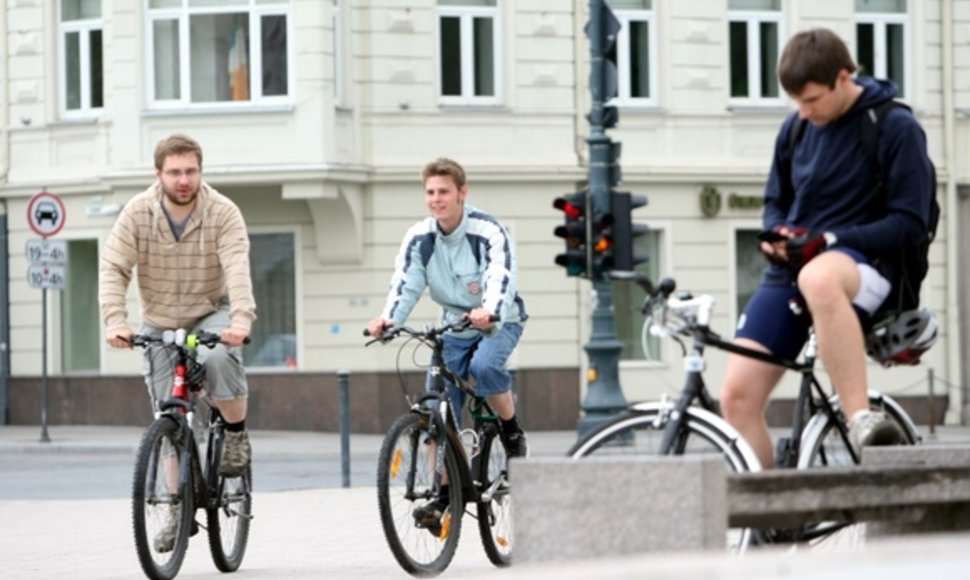According to city officials, Vilnius has more that 80 kilometers of bikeways. Most of them are just markings on sidewalks or roadsides. Cyclists, however, meet such estimates with ironic grins.
Merely six kilometers
“On paper, everything looks nice, but in practice, there's no money. Neither for new bikeways, nor for mending old ones. Vilnius is in a desperate situation,” regrets Eduardas Kriščiūnas, board member of the Lithuanian Cyclist Society and former advisor to Vilnius Mayor.
In his own calculations, Vilnius has merely six kilometers of tracks that are suitable for children on bikes – since, according to traffic rules, minors under 14 years old are not allowed to ride on streets. If kids have taken a special course and get a certificate, they can use bikeways on streets after they turn 12.
Kriščiūnas is convinced it would not take millions to touch up existing bikeways or moderately improve Vilnius cycling network. 200 thousand litas would have sufficed, but the sum that had initially been allocated to cyclists in draft budget proposal, was later directed somewhere else. This money would be enough to build about 2 kilometers of new tracks. “We're not crossing out the entire year yet. Since we truly do not need that much money, perhaps it will turn up after they review the budget,” Krikščiūnas hopes.
Pauper's transport?
Krikščiūnas lists some of the things that could be done on a moderate budget: connecting existing tracks, so they do not lead nowhere; building new bikeways between Narbutas street and Birutė street; connecting Pilaitė district with Laisvė avenue. Unfortunately, cycling infrastructure is not a priority for city officials – even though many of them, according to Krikščiūnas, readily ride bikes.
“But it's not only up to the City Council how to allocate the money. Much depends on people in the municipal administration. Since they certainly do not ride bikes – and, moreover, regard cyclists contemptuously, as “only paupers ride bikes” – it's only natural that no one pays much attention to it,” Krikščiūnas resents.
Better situation out of town
The situation gradually improves going further away from the city centre. There is a 5-kilometer track in Verkiai Regional Park, between Santariškės roundabout to the Green Lakes. Cyclists can also use forest paths – the park contains a total of 14 kilometers of tracks suitable for cycling.
On the other side of town, Pavilniai Regional Park is less suited for cycling because of its hilly terrain. Vida Petiukonienė, management head of both parks, notes, however, that cyclists have come to like pedestrian paths in Pavilniai park. One can even note new trampled down paths alongside stairways – left by people taking their bikes uphill.
“We would like to connect the bikeway along the river Neris between the city centre and Trinapolis Monastery with the network in Verkiai Regional Park. But it is difficult for cyclists to ride from Trinapolis Monastery to Verkiai Palace,” Petiukonienė says.
Provisional solutions
Each summer season, the city authorities turn parts of Verkiai street into a bikeway, allowing only one-way car traffic. However, this is only a temporary solution, in Petiukonienė's view. It would be best to have a separate bikeway so that cyclists can take an uninterrupted ride from the city centre to the Green Lakes.
Over the past several years, there have been attempts to direct cyclists from Trinapolis Monastery towards Verkiai Palace via paths along Way of the Cross. However, Way of the Cross (Kryžiaus kelias) is one of Lithuania's pilgrimage sites, known in other parts of Europe too, therefore Petiukonienė thinks it inadvisable to lump pedestrian and cycling paths together.
According to the director of Verkiai and Pavilniai Regional Parks, bikeways require constant maintenance. The pavement constantly deteriorates due to rainfall, while vandals occasionally do damage to traffic signs and bars. Fortunately, according to the park management, war against vandalism is getting better – each year they see less purposeful damage.
Example in Panevėžys
Panavėžys is often presented as an example to other Lithuanian towns in terms of planning and building cycling infrastructure. The town and its suburbs contain about 130 kilometers of interconnected bikeways. People can cycle from one zone of the town to another. The impulse to develop infrastructure was given by Panevėžys cycling enthusiasts who initially did much of the work themselves – they organized working bees and mended paths. The city authorities soon followed their suite. Panevėžys started paying attention to its cycling network 16 years ago.













